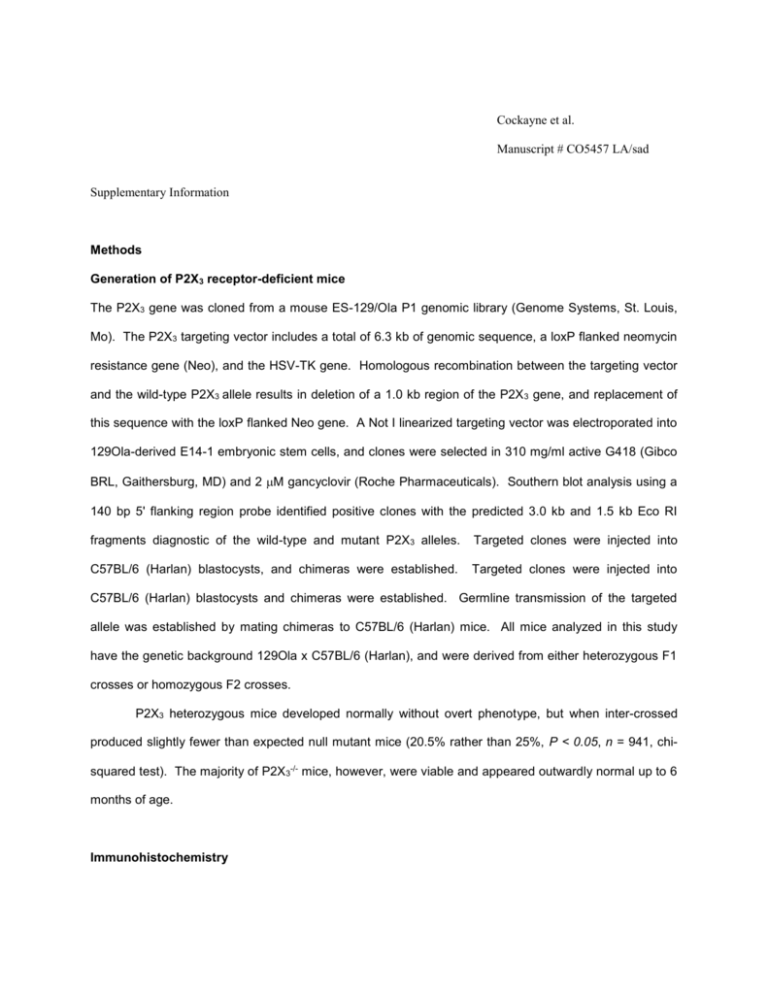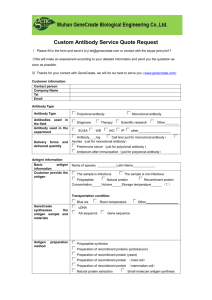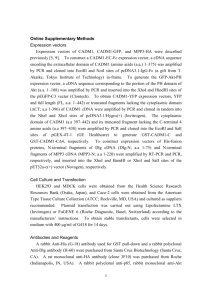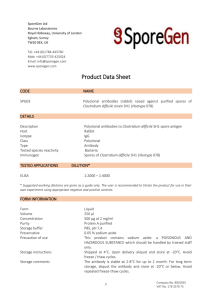Normal.dot
advertisement

Cockayne et al. Manuscript # CO5457 LA/sad Supplementary Information Methods Generation of P2X3 receptor-deficient mice The P2X3 gene was cloned from a mouse ES-129/Ola P1 genomic library (Genome Systems, St. Louis, Mo). The P2X3 targeting vector includes a total of 6.3 kb of genomic sequence, a loxP flanked neomycin resistance gene (Neo), and the HSV-TK gene. Homologous recombination between the targeting vector and the wild-type P2X3 allele results in deletion of a 1.0 kb region of the P2X 3 gene, and replacement of this sequence with the loxP flanked Neo gene. A Not I linearized targeting vector was electroporated into 129Ola-derived E14-1 embryonic stem cells, and clones were selected in 310 mg/ml active G418 (Gibco BRL, Gaithersburg, MD) and 2 M gancyclovir (Roche Pharmaceuticals). Southern blot analysis using a 140 bp 5' flanking region probe identified positive clones with the predicted 3.0 kb and 1.5 kb Eco RI fragments diagnostic of the wild-type and mutant P2X3 alleles. Targeted clones were injected into C57BL/6 (Harlan) blastocysts, and chimeras were established. Targeted clones were injected into C57BL/6 (Harlan) blastocysts and chimeras were established. Germline transmission of the targeted allele was established by mating chimeras to C57BL/6 (Harlan) mice. All mice analyzed in this study have the genetic background 129Ola x C57BL/6 (Harlan), and were derived from either heterozygous F1 crosses or homozygous F2 crosses. P2X3 heterozygous mice developed normally without overt phenotype, but when inter-crossed produced slightly fewer than expected null mutant mice (20.5% rather than 25%, P < 0.05, n = 941, chisquared test). The majority of P2X3-/- mice, however, were viable and appeared outwardly normal up to 6 months of age. Immunohistochemistry Polyclonal antibodies against rat P2X1-7 receptor subunits were used as previously described 1. Colocalization of P2X3 and P2X2 in DRG was carried out as described2, except that the rabbit polyclonal P2X3 antibody (1:500) and sheep polyclonal P2X 2 antibody (1:250) were followed by Alexa 488 goat antirabbit and Alexa 594 donkey anti-sheep IgG conjugates (1:200), respectively. Colocalization of P2X 3 and the lectin IB4 in DRG was carried out as described 3, except that incubation with the rabbit polyclonal P2X3 antibody (1:500) was carried out for 48 h. For colocalization in spinal cord and skin, sections were immunostained for P2X3 using indirect tyramide signal amplification as previously described3, with the polyclonal P2X3 antibody diluted to 1:700 for spinal cord and 1:1000 for skin. Following serum and primary antibody incubation, skin sections were incubated with rabbit polyclonal PGP 9.5 antibody (Ultraclone, Isle of Wight, UK; 1:1000, 24 h), followed by TRITC-conjugated goat anti-rabbit antibody (Jackson, Luton, UK; 1:200, 5 h). Spinal cord sections were incubated with IB4 (Sigma; 10 g/ml, 24 h), followed by goat anti-IB4 antibody (Vector Laboratories Inc., Burlingame, CA; 1:2000, 24 h), and TRITCconjugated donkey anti-goat antibody (Jackson; 1:200, 3 h). To allow direct comparison of colocalized immunoreactivity images were pseudocolored and merged using Adobe Photoshop. For whole-mount bladder preparations, bladders were removed into Kreb's medium and pinned out on sylgard (Merke, Poole, Dorset, UK). The epithelium was stripped away from the muscle and stretched out on the sylgard (Merke, Poole, Dorset, UK) to expose the suburothelial plexus. Whole mounts were fixed (4% formaldehyde in 0.1 M phosphate buffer, 1 h, room temperature) and blocked with normal horse serum (10% NHS; 30 min). Incubation with P2X 3 (5 g/ml) and capsaicin (VR-1) receptor (Chemicon, Temecula, CA; 1:2000) antibodies, diluted in PBS containing BSA, Lysine, Triton X-100, and sodium azide (Sigma), was carried out overnight at room temperature. Primary antibody incubation was followed with donkey anti-rabbit IgG (Jackson, Luton, UK; 1:500 in 1% NHS; 1 h) and streptavidin FITC (Amersham, Bucks, UK; 1:100; 1 h). Whole mounts were incubated in Pontamine Sky Blue for 5 min to reduce autofluorescence, and images were captured using confocal microscopy. and P2X3-/- tissues were processed simultaneously to facilitate direct comparison. In all cases, P2X3+/+ References 1. 2. 3. Oglesby, I. B., Lachnit, W. G., Burnstock, G. & Ford, A. P. D. W. Subunit specificity of polyclonal antisera to the carboxy terminal regions of P2X receptors, P2X1 through P2X7. Drug Development Research 47, 189-195 (1999). Novakovic, S. D. et al. Immunocytochemical localization of P2X3 purinoceptors in sensory neurons in naive rats and following neuropathic injury. Pain 80, 273-82 (1999). Bradbury, E. J., Burnstock, G. & McMahon, S. B. The expression of P2X3 purinoreceptors in sensory neurons: Effects of axotomy and glial-derived neurotrophic factor. Molecular and Cellular Neuroscience 12, 256-268 (1998).






